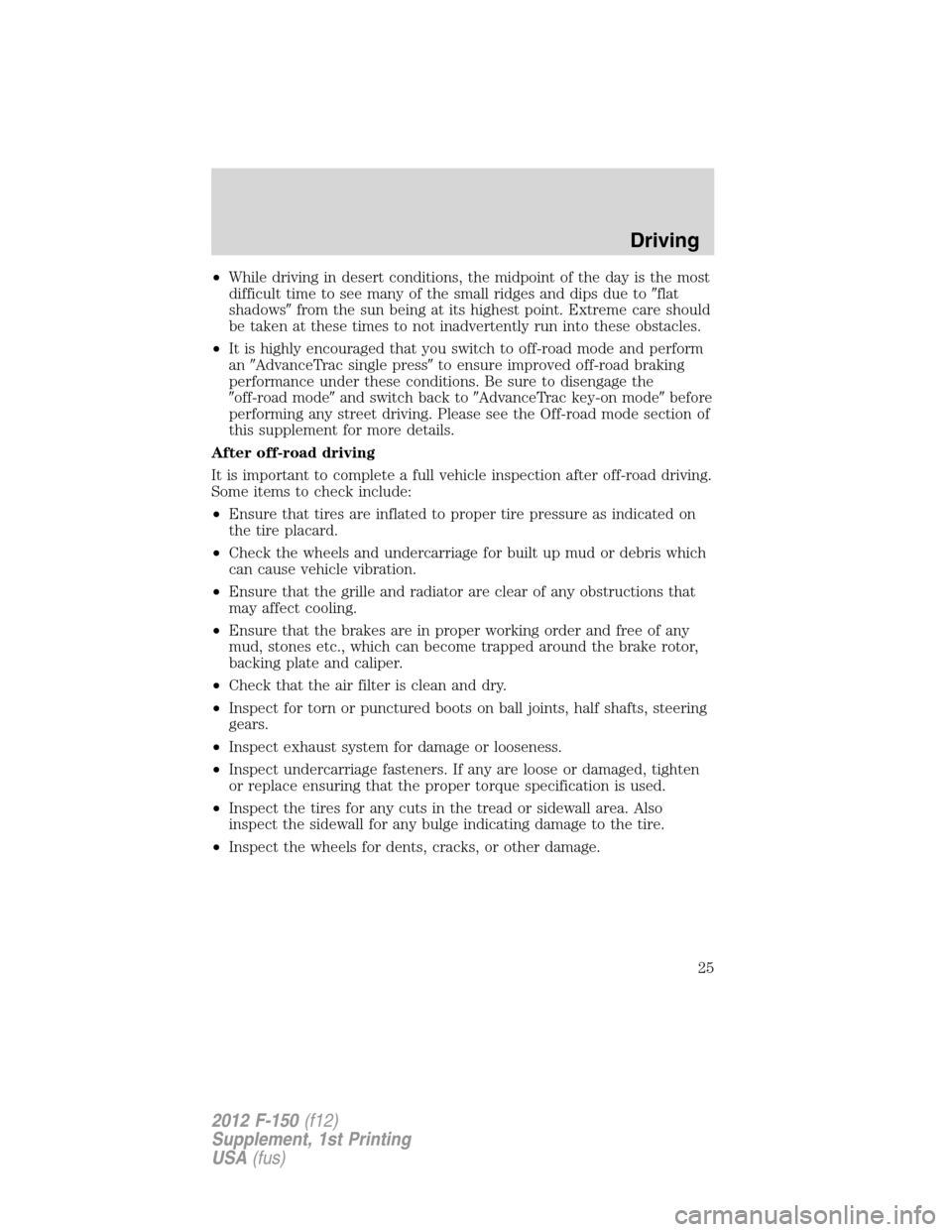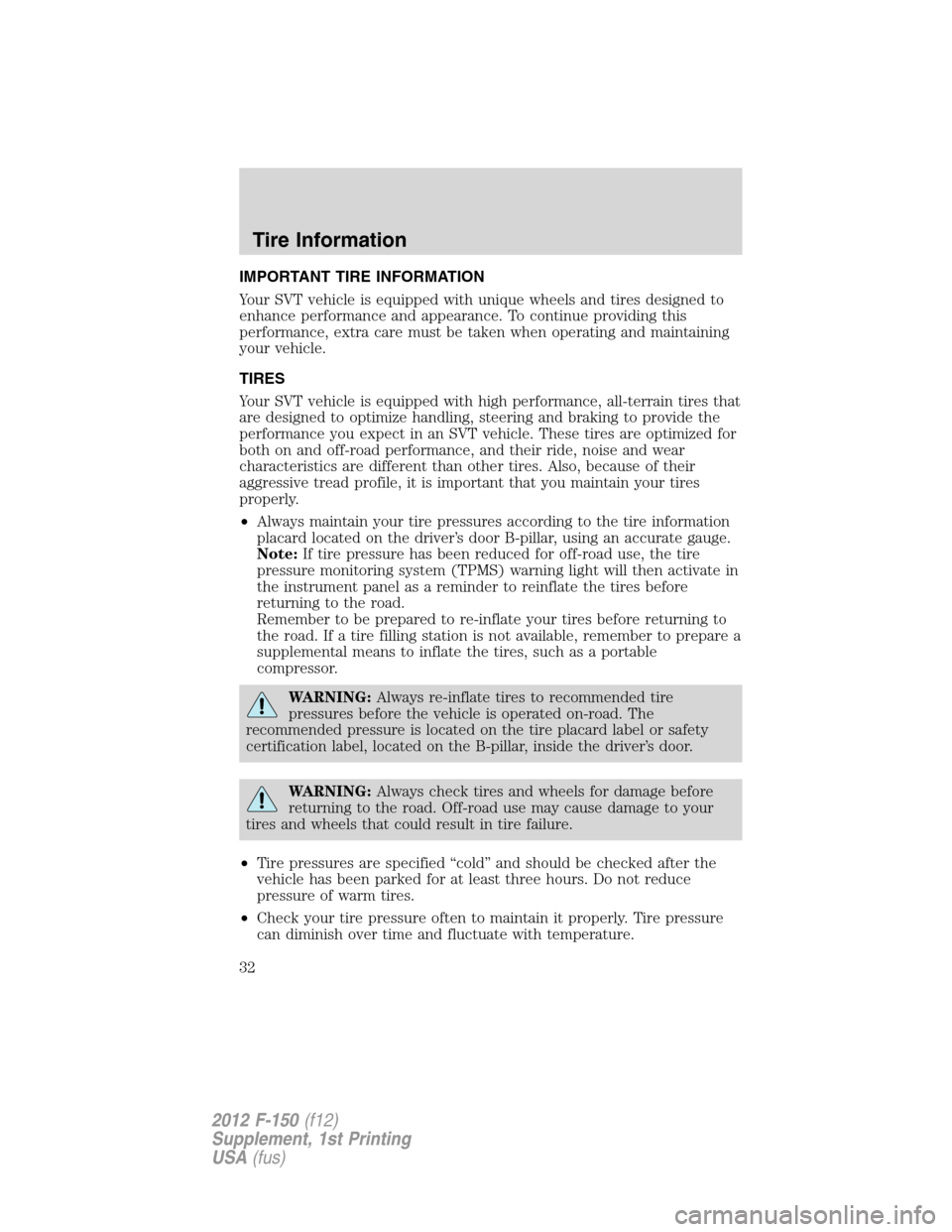Page 25 of 36

•While driving in desert conditions, the midpoint of the day is the most
difficult time to see many of the small ridges and dips due to�flat
shadows�from the sun being at its highest point. Extreme care should
be taken at these times to not inadvertently run into these obstacles.
•It is highly encouraged that you switch to off-road mode and perform
an�AdvanceTrac single press�to ensure improved off-road braking
performance under these conditions. Be sure to disengage the
�off-road mode�and switch back to�AdvanceTrac key-on mode�before
performing any street driving. Please see the Off-road mode section of
this supplement for more details.
After off-road driving
It is important to complete a full vehicle inspection after off-road driving.
Some items to check include:
•Ensure that tires are inflated to proper tire pressure as indicated on
the tire placard.
•Check the wheels and undercarriage for built up mud or debris which
can cause vehicle vibration.
•Ensure that the grille and radiator are clear of any obstructions that
may affect cooling.
•Ensure that the brakes are in proper working order and free of any
mud, stones etc., which can become trapped around the brake rotor,
backing plate and caliper.
•Check that the air filter is clean and dry.
•Inspect for torn or punctured boots on ball joints, half shafts, steering
gears.
•Inspect exhaust system for damage or looseness.
•Inspect undercarriage fasteners. If any are loose or damaged, tighten
or replace ensuring that the proper torque specification is used.
•Inspect the tires for any cuts in the tread or sidewall area. Also
inspect the sidewall for any bulge indicating damage to the tire.
•Inspect the wheels for dents, cracks, or other damage.
Driving
25
2012 F-150(f12)
Supplement, 1st Printing
USA(fus)
Page 26 of 36
WRECKER TOWING
If you need to have your vehicle towed, contact your roadside assistance
center or a professional towing service.
It is required that your vehicle be towed with flatbed equipment. When
towing with a flatbed, 4x4 blocks must be used when loading/unloading
your vehicle. Do not tow with a slingbelt. Ford Motor Company has not
approved a slingbelt towing procedure.
If the vehicle is towed by other means or incorrectly, vehicle
damage may occur.
Roadside Emergencies
26
2012 F-150(f12)
Supplement, 1st Printing
USA(fus)
Page 27 of 36
WASHING YOUR F-150 SVT RAPTOR
Do not drive your vehicle through an automated, commercial car
wash due to the vehicle’s tire width and track. Wash your vehicle
by hand, or by using a touchless commercial wash with no
mechanical tracks on the floor. Do not use a commercial or high
pressure wand on the bed side graphic surface or graphics edges.
Cleaning
27
2012 F-150(f12)
Supplement, 1st Printing
USA(fus)
Page 28 of 36
MOTORCRAFT PART NUMBERS
Component 6.2L V8 engine
Air filter element FA-1883
Battery BTX-59 or BTX-65-650
1
Oil filter FL-820S
Spark plugs2
1
Heavy-duty battery, if equipped
2For spark plug replacement, see your authorized dealer. Refer to
scheduled maintenance informationfor the appropriate intervals for
changing the spark plugs.
Replace the spark plugs with ones that meet Ford material and
design specifications for your vehicle, such as Motorcraft or
equivalent replacement parts. The customer warranty may be
void for any damage to the engine if such spark plugs are not
used.
Maintenance
28
2012 F-150(f12)
Supplement, 1st Printing
USA(fus)
Page 29 of 36

MAINTENANCE PRODUCT SPECIFICATIONS AND CAPACITIES
Item CapacityFord part name or
equivalentFord part number /
Ford Specification
Engine oil (includes
filter change)
5
7.0 quarts
(6.6L)•Motorcraft SAE 5W-20
Premium Synthetic Blend
Motor Oil (US)
•Motorcraft SAE 5W-20 Full
Synthetic Motor Oil (US)
•Motorcraft SAE 5W-20
Super Premium Motor Oil
(Canada)
•Motorcraft SAE 5W-20
Synthetic Motor Oil
(Canada)•XO-5W20-QSP (US)
•XO-5W20-QFS (US)
•CXO-5W20–LSP12
(Canada)
•CXO-5W-20-LFS12
(Canada) /
WSS-M2C945-A and
API Certification Mark
Engine coolant
1
16.0L
(16.9 quarts)Motorcraft Specialty Orange
Engine Coolant with
bittering agent (US) /
Motorcraft Specialty Orange
Engine Coolant (Canada)VC-3-B (US)
CVC-3-B (Canada) /
WSS-M97B44-D
Front axle lubricant 1.7L (3.6 pints)Motorcraft SAE 80W-90
Premium Rear Axle
LubricantXY-80W-90–QL /
WSP-M2C197–A
Rear axle lubricant 2.6L (5.5 pints)
2
Motorcraft SAE 75W-140
High Performance Synthetic
Rear Axle LubricantXY-75W140-QL /
WSL-M2C192–A
Maintenance
29
2012 F-150(f12)
Supplement, 1st Printing
USA(fus)
Page 30 of 36

Item CapacityFord part name or
equivalentFord part number /
Ford Specification
Rear axle fluid friction
modifier4 oz. (118 ml) Additive Friction ModifierXL-3
EST-M2C118-A
Fuel tank26 gallons
(98.4L)——
Transmission fluid
3
12.4L
(13.1 quarts)
4
Motorcraft
MERCON�LV AT FXT-10-QLV /
MERCON�LV
Transfer case lubricant1.4-1.5L
(2.9-3.1 pints)Motorcraft Transfer Case
FluidXL-12 / —
1Add the coolant type originally equipped in your vehicle.2Fill 6 mm to 14 mm (1/4 inch to 9/16 inch) below bottom of fill hole.
Your vehicle’s rear axle is filled with a synthetic rear axle lubricant and is considered lubricated for
life. These lubricants do not need to be checked or changed unless a leak is suspected, service is
required or the axle assembly has been submerged in water. The axle lubricant should be changed
any time the rear axle has been submerged in water.3Ensure the correct automatic transmission fluid is used. Transmission fluid requirements are
indicated on the dipstick or on the dipstick handle. Check the container to verify the fluid being
added is of the correct type. Refer to yourscheduled maintenance informationto determine the
correct service interval.4Approximate dry fill capacity including transmission fluid cooling system, actual refill capacities
will vary based on vehicle application and transmission fluid cooling system (i.e. coolers size,
cooling lines, auxiliary cooler capacities). The amount of transmission fluid and fluid level should
be set by the indication on the dipstick’s normal operating range.5Use of synthetic or synthetic blend motor oil is not mandatory. Engine oil need only meet the
requirements of Ford specification WSS-M2C945-A and the API Certification mark.
Maintenance
30
2012 F-150(f12)
Supplement, 1st Printing
USA(fus)
Page 31 of 36

OCTANE RECOMMENDATIONS
Regular unleaded gasoline with a
pump (R+M)/2 octane rating of 87 is
recommended. Some stations offer
fuels posted as�Regular�with an
octane rating below 87, particularly
in high altitude areas. Fuels with octane levels below 87 are not
recommended. Premium fuel will provide improved performance and is
recommended for severe duty usage such as trailer tow.
Do not be concerned if your engine sometimes knocks lightly. However, if
it knocks heavily under most driving conditions while you are using fuel
with the recommended octane rating, see your authorized dealer to
prevent any engine damage.
WHEELS AND TIRES
TiresLT315/70R17 BSW tires
WheelsSVT-Signature style, 17 in x 8.5 in
aluminum 6-spoke wheels
TIRE ROTATION
Because your vehicle’s tires perform
different jobs, they often wear
differently. To make sure your tires
wear evenly and last longer, have
them rotated.Note:The F-150
Raptor requires tire rotations every
5,000 miles (8,000 km). If you
notice that the tires wear unevenly,
have them checked.
SPARE TIRE AND WHEEL
Your vehicle is equipped with an LT315/70R17 spare tire. The spare
tire/wheel assembly has the same capability as the road tire/wheel
assembly, but is not equipped with a tire pressure monitoring sensor.
87(R+M)/2 METHOD
Maintenance
31
2012 F-150(f12)
Supplement, 1st Printing
USA(fus)
Page 32 of 36

IMPORTANT TIRE INFORMATION
Your SVT vehicle is equipped with unique wheels and tires designed to
enhance performance and appearance. To continue providing this
performance, extra care must be taken when operating and maintaining
your vehicle.
TIRES
Your SVT vehicle is equipped with high performance, all-terrain tires that
are designed to optimize handling, steering and braking to provide the
performance you expect in an SVT vehicle. These tires are optimized for
both on and off-road performance, and their ride, noise and wear
characteristics are different than other tires. Also, because of their
aggressive tread profile, it is important that you maintain your tires
properly.
•Always maintain your tire pressures according to the tire information
placard located on the driver’s door B-pillar, using an accurate gauge.
Note:If tire pressure has been reduced for off-road use, the tire
pressure monitoring system (TPMS) warning light will then activate in
the instrument panel as a reminder to reinflate the tires before
returning to the road.
Remember to be prepared to re-inflate your tires before returning to
the road. If a tire filling station is not available, remember to prepare a
supplemental means to inflate the tires, such as a portable
compressor.
WARNING:Always re-inflate tires to recommended tire
pressures before the vehicle is operated on-road. The
recommended pressure is located on the tire placard label or safety
certification label, located on the B-pillar, inside the driver’s door.
WARNING:Always check tires and wheels for damage before
returning to the road. Off-road use may cause damage to your
tires and wheels that could result in tire failure.
•Tire pressures are specified “cold” and should be checked after the
vehicle has been parked for at least three hours. Do not reduce
pressure of warm tires.
•Check your tire pressure often to maintain it properly. Tire pressure
can diminish over time and fluctuate with temperature.
Tire Information
32
2012 F-150(f12)
Supplement, 1st Printing
USA(fus)